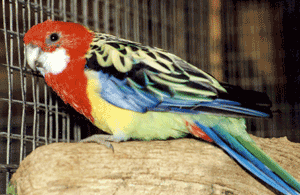 by Jim Hayward
by Jim Hayward
ORIGINAL HOMELAND:
There is a broad band of distribution of the Eastern Rosella on mainland Australia, from south-eastern South Australia, through Victoria into New South Wales; the brilliant Golden-mantled type becomes evident from the area of the Hunter River Valley in New South Wales and carries on northwards into south-eastern Queensland. The bulkier Tasmanian sub-species, with its larger white cheek patches, is confined to eastern areas of the island. Easterns have been introduced into New Zealand and populations exist on both North and South Islands.
NATURAL HABITAT:
This parrakeet lives in areas of open woodland, amongst trees adjacent to waterways; it is seen in orchards, parks and gardens and has actually benefited from the clearing of large areas of thicker forest for agricultural purposes - especially the areas set aside for growing of cereals.
STATUS IN THE WILD:
A common species.
STATUS IN AVICULTURE:
Widely bred and ever popular.
LEVEL OF KEEPER'S EXPERIENCE:
Suitable for novices with basic bird keeping experience.
HARDINESS:
Hardy and not prone to frost bite, but needs protection from cutting winds.
TYPE OF ACCOMMODATION:
An open fronted shelter with a flight measuring a minimum of twelve feet long by six feet high and three feet wide is suitable.
TYPE OF DIET:
The usual parrakeet seed mixture, plus fruit, greenfood, berries and budding branches, keeps them in good condition; softfood (canary rearing food and/or bread and milk) should be provided during the nesting and rearing period.
SEXING:
Easterns are easily sexed by the brighter and more sharply defined colours of the cock as opposed to the rather toned down colouration of the hen; the red on his head reaches further down the back of the neck than does that of the hen, and is sharply delineated at the point where it meets the black and yellow feathering. The bill and head of the cock is larger than that of the hen, as are the cheek patches; these differences can also be clearly seen even in fledglings.
SEXUAL MATURITY:
Both cocks and hens of only one year old - youngsters from a pair's first brood of the season - will attempt to breed, usually a week or more later than older adults.
NESTING SEASON IN BRITAIN:
From early spring to summer.
TYPE OF NEST:
A hanging nest-box measuring about seven inches square inside by around two feet high, set at a slight angle and fixed at head height under some cover is readily accepted.
USUAL NUMBER OF EGGS:
Though clutches of nine eggs and even more are known, five eggs is normal.
INCUBATION PERIOD:
Incubation takes eighteen or nineteen days.
USUAL NUMBER OF YOUNG:
Four to five is a good nest.
FLEDGING AGE:
The fledglings leave the nest when about five weeks old.
USUAL NUMBER OF CLUTCHES:
Can be double brooded.
NESTING HABITS:
In the wild, if hollow branches and trunks of trees are in short supply, they are willing to make do with rotting telegraph poles or stumps of fence posts; once possession is claimed the cock guards the site against other nest seekers, allowing the hen to complete her work in excavating and altering the entrance and hollow to her satisfaction. His aggressive actions towards interlopers include the tail wagging of the courtship ritual, rapid chattering and a thrusting forward of his shoulders with bill tucked into his throat feathers.
SPECIAL CONSIDERATIONS:
Non aggressive species must be chosen as neighbours; closely related parrakeets like other Rosellas and Redrumps will squabble, fight through the wire and disrupt breeding.
NOISE FACTOR:
Their calls are cheerful and musical, with only occasional louder alarm calls made when they are frightened.
AVAILABILITY:
Frequently offered for sale.
COLOUR VARIETIES:
Colour varieties have really taken off, with the Lutino, the Ruby (Red) and their combination the Rubino being highly popular; other varieties include Cinnamon, Pied, Dilute and - in Australia - Melanistic or Black.
